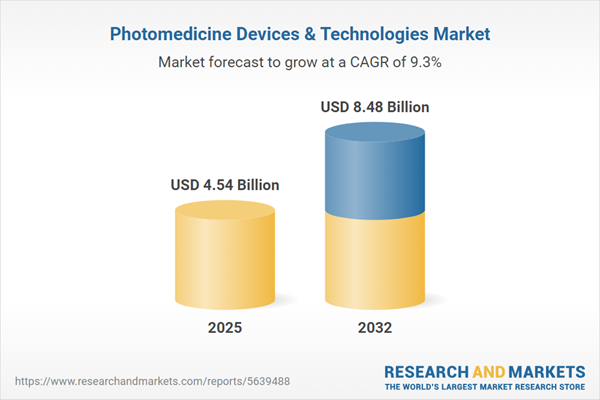Speak directly to the analyst to clarify any post sales queries you may have.
The Photomedicine Devices & Technologies Market continues to transform clinical care, leveraging advanced light-based and laser solutions for a range of medical applications in mainstream and specialist healthcare environments.
Market Snapshot: Photomedicine Devices & Technologies Market
The global photomedicine devices and technologies market is experiencing robust expansion. The market grew from USD 4.17 billion in 2024 to USD 4.54 billion in 2025. It is projected to grow at a CAGR of 9.27%, reaching USD 8.48 billion by 2032. This growth is driven by technological breakthroughs, expanding clinical applications, regulatory evolution, and increasing adoption across dental, dermatology, and ophthalmic care.
Scope & Segmentation
This comprehensive market research offers granular coverage of the industry's landscape, focusing on core segments, technologies, end uses, and regional breakouts relevant for strategic growth planning.
- Product Type: Dental laser devices, dermatology devices, ophthalmic devices
- Component: Dichroic lamps, full spectrum light, lasers, light emitting diodes, polychromatic polarized light
- Deployment: Portable, stationary systems
- Application: Aesthetic procedures (including hair removal and skin rejuvenation), cardiovascular diseases, dermatology (acne treatment, scar removal, tattoo removal), neurology, oncology, pain management, wound healing
- End-User: Ambulatory surgical centers, homecare settings, hospitals and clinics, research and academic institutions
- Region: Americas (United States, Canada, Mexico, Brazil, Argentina, Chile, Colombia, Peru), Europe, Middle East & Africa (United Kingdom, Germany, France, Russia, Italy, Spain, Netherlands, Sweden, Poland, Switzerland, United Arab Emirates, Saudi Arabia, Qatar, Turkey, Israel, South Africa, Nigeria, Egypt, Kenya), Asia-Pacific (China, India, Japan, Australia, South Korea, Indonesia, Thailand, Malaysia, Singapore, Taiwan)
- Companies Profiled: Alma Lasers Ltd., Asclepion Laser Technologies GmbH, Aspen Laser, LLC, biolitec AG, Cutera, Inc., Erchonia Corporation, Fotona d.o.o., GE HealthCare Technologies Inc., InMode Ltd., Iridex Corporation, Koninklijke Philips N.V., LightStim LLC, Lumenis Ltd., Lutronic Co., Ltd., Lynton Lasers Inc., Palomar Medical Technologies, Inc., PhotoMedex Inc., Quanta System Ltd., Sciton, Inc., THOR Photomedicine Ltd., Toshiba Corporation, Venus Concept, Inc.
Key Takeaways and Strategic Insights
- Cutting-edge laser, LED, and polychromatic technologies are broadening the scope of minimally invasive procedures in dental, skin, and vision health.
- Portable deployment and telemedicine integration are expanding treatment beyond hospital settings into ambulatory and homecare use, supporting care decentralization.
- Digital health, artificial intelligence, and smart control systems are optimizing operational efficiency, from treatment planning to outcome monitoring and remote patient management.
- Regional variations in reimbursement models and regulatory frameworks are prompting vendors to adapt market entry strategies and prioritize clinical evidence in product development.
- Competitive momentum is sustained through investments in proprietary light sources, partnership-driven innovation, and lifecycle service models that increase customer retention and recurring revenue.
- Diversified sourcing and localized production have become pivotal, enabling supply chain resilience in the face of trade policy shifts and input cost fluctuations.
Tariff Impact: Navigating US Import Duties on Photomedicine Components
In early 2025, cumulative tariffs enacted in the United States on photomedicine components introduced notable supply chain and cost complexities. Manufacturers responded by streamlining supply networks, investing in regional production hubs, and partnering with domestic suppliers. Some short-term impacts included adjusted pricing and deferred capital expenditures by providers, while long-term effects may yield greater supplier diversification and operational resilience.
Methodology & Data Sources
Research for this report combines in-depth secondary analysis with comprehensive interviews involving clinical practitioners, R&D specialists, procurement leads, and industry policy experts. Data triangulation between published sources and primary insights underpins the accuracy and relevance of findings. Segmentation analysis across technology, application, deployment, and regional dimensions ensures actionable granularity for senior decision-makers.
Why This Report Matters
- Equip your organization with strategic insights required for market entry, investment prioritization, and long-term planning within the photomedicine devices domain.
- Understand the impact of shifting supply chains, regulatory landscapes, and emerging technologies to shape innovation and procurement strategies.
Conclusion
The photomedicine devices and technologies market is evolving quickly, driven by advancements in component innovation, regional expansion, and digital health integration. Decision-makers can leverage this research to guide investments, strengthen market positioning, and realize new opportunities across this dynamic sector.
Additional Product Information:
- Purchase of this report includes 1 year online access with quarterly updates.
- This report can be updated on request. Please contact our Customer Experience team using the Ask a Question widget on our website.
Table of Contents
3. Executive Summary
4. Market Overview
7. Cumulative Impact of Artificial Intelligence 2025
Companies Mentioned
The companies profiled in this Photomedicine Devices & Technologies market report include:- Alma Lasers Ltd.
- Asclepion Laser Technologies GmbH
- Aspen Laser, LLC
- biolitec AG
- Cutera, Inc.
- Erchonia Corporation
- Fotona d.o.o.
- GE HealthCare Technologies Inc.
- InMode Ltd.
- Iridex Corporation
- Koninklijke Philips N.V.
- LightStim LLC
- Lumenis Ltd.
- Lutronic Co., Ltd.
- Lynton Lasers Inc.
- Palomar Medical Technologies, Inc.
- PhotoMedex Inc.
- Quanta System Ltd.
- Sciton, Inc.
- THOR Photomedicine Ltd.
- Toshiba Corporation
- Venus Concept, Inc.
Table Information
| Report Attribute | Details |
|---|---|
| No. of Pages | 184 |
| Published | November 2025 |
| Forecast Period | 2025 - 2032 |
| Estimated Market Value ( USD | $ 4.54 Billion |
| Forecasted Market Value ( USD | $ 8.48 Billion |
| Compound Annual Growth Rate | 9.2% |
| Regions Covered | Global |
| No. of Companies Mentioned | 23 |









